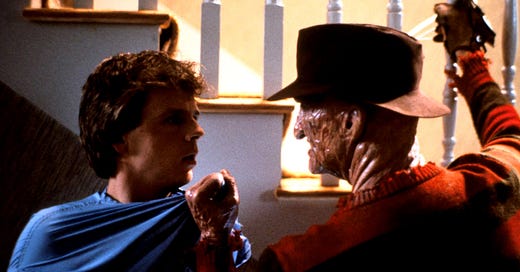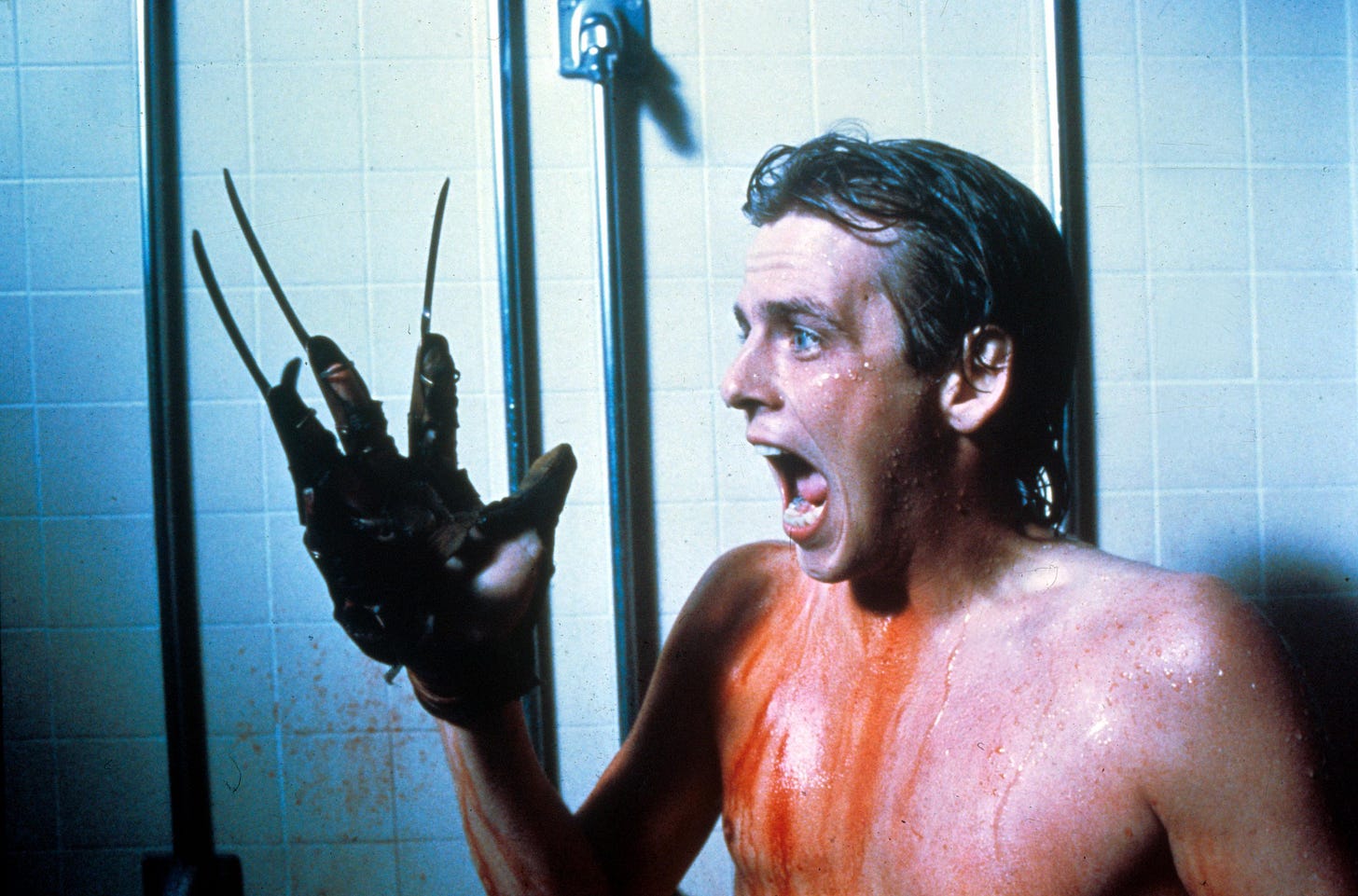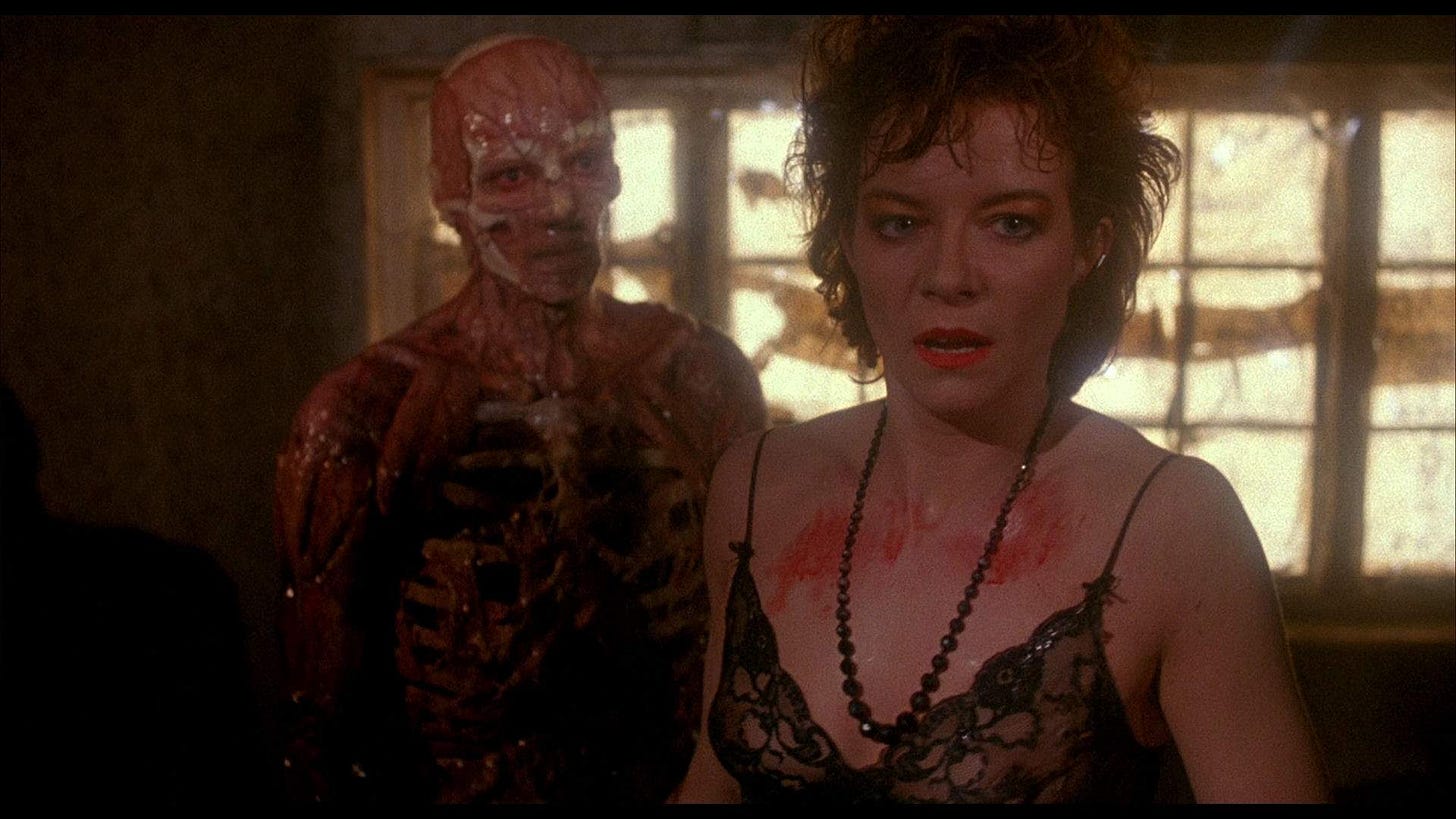SHOCKTOBER: A Nightmare on Elm Street 2: Freddy's Revenge (1985)
Dissecting the botched sequel to a horror classic. Plus: Hellraiser (1987).
It’s spooky season. Every year, my wife and I spend October exploring the cinematic eerie, macabre, and downright frightening in an annual tradition we call SHOCKTOBER. I’ll be posting weekly write-ups for this year’s selections here at Discontent Dispatch.
A Nightmare on Elm Street 2: Freddy’s Revenge (1985)
The concept for Wes Craven’s original Nightmare on Elm Street – a killer who stalks dreams – is simple but ingenious. If your dreams aren’t safe, there’s nowhere to hide. No one can sleep forever. If Freddy Krueger wants you, he’ll get you.
The first Nightmare was one of our favorites last year, so we went into the sequel hoping for the best. Unfortunately, A Nightmare on Elm Street 2: Freddy’s Revenge gets Nightmare on Elm Street wrong – so wrong, in fact, that I honestly can’t tell what movie director Jack Sholder, writer David Chaskin, and the rest of the film’s creative team thought they were making. If anything, it’s interesting as a case study in filmmakers badly misunderstanding their own material. But that’s a pretty big if.
A quick plot summary. Five years after the original Nightmare, a new family has moved into the house on 1428 Elm Street. Jesse Walsh (Mark Patton), who now occupies Nancy Thompson’s old room, is having trouble sleeping. The room is hot, for one – boiling, really. Then there are Jesse’s nightmares, all of which are haunted by a familiar face. Freddy Krueger (the immortal Robert Englund) uses one such dream to explain his purpose: he wants Jesse to kill for him – and, after a dramatically appropriate amount of resistance, Jesse begins doing just that. As the body count rises and Freddy increases his control, it’s up to Jesse’s girlfriend Lisa Webber (Kim Myers) to stop him.
If you’ve seen the first film, this synopsis will begin to raise questions. For example: why would Freddy Krueger, one of horror cinema’s most fearsome killers, need to recruit someone else to do his killing for him? And why do the dream elements feel like such an afterthought?
The more one pulls on these threads, the more Freddy’s Revenge starts to unravel. If there’s some reason why Krueger can’t just enter his victims’ dreams and kill them, it’s never given. That would have at least justified his need to bring in a surrogate. But the movie can’t fully stick to even that constraint. In several scenes, Freddy moves objects in the real world on his own. It’s unclear why, if Freddy is so intent on taking out his victims while they’re awake, he can’t just kill them himself.
Maybe it shouldn’t be a surprise that Freddy’s Revenge makes no conceptual sense, though, since the movie lacks even basic narrative competence. Instead of using conventional dramatic tools like plot development and characterization to make the stakes clear to the viewer – telling the story, in other words – the movie instead asks them to accept everything on faith. Jesse’s descent into insanity, for example, isn’t conveyed so much as dictated. For every scene with a nightmare vision of Freddy Krueger, there are two or three depicting Jesse’s apparently normal life as a high school student. The whole thing feels disjointed; there’s no connective narrative tissue from scene to scene. We can’t infer that Jesse is going insane, we can only take his word for it when he tells us so.
A slasher should at least have memorable kill scenes; Freddy’s Revenge has exactly one. The killing of Jesse’s friend Ron (Robert Rusler) is the film’s lone highlight. Fearing Freddy’s imminent return, Jesse bunks with Ron for the night, asking his friend to keep an eye on him. Of course, Ron doesn’t, and Freddy does return, literally bursting out of Jesse’s body before impaling Ron on his glove. It’s a great scene, pure Nightmare on Elm Street, with all the visceral terror the series can deliver at its best.
The other kills range from forgettable to comically bad, with one deserving a special mention. Freddy/Jesse’s first victim is Coach Schneider (Marshall Bell), a thuggish high school gym teacher who tyrannizes Jesse and Ron throughout the first act (and, as Ron notes at one point, apparently spends his nights and weekends at an S&M bar). Schneider’s death, and the events leading up to it, rank among the most unintentionally funny things I’ve ever seen in a movie. It’s so ridiculous I laughed out loud.
Though not a dream (since it’s apparently too much to expect dream sequences in a Nightmare on Elm Street movie), the sequence leading up to Schneider’s death is plenty surreal. At first, the reference to Schneider’s extracurricular proclivities seems like a throwaway line or a bad joke – until a fitfully sleeping Jesse leaves his house, walks to an S&M bar, and finds Schneider there. Then, for some reason, they both go back to the high school, where Schneider, still dressed in his leather getup, makes Jesse run laps, presumably as punishment for – well, for something. Gossiping about his personal life, maybe? It’s never really explained.
After Jesse hits the showers, the real trouble begins. Schneider’s office begins shaking, really shaking, like a 7.5 on the Richter Scale. But this is no earthquake – it’s Freddy Krueger. Sporting equipment – tennis balls, basketballs, etc. – hurls itself at Schneider like a battery of ballistic missiles. He ducks for cover, but it’s no use. Snakelike towels curl themselves around his wrists. They slowly drag him out to the showers and string him up between two showerheads, hanging him like a prize catch.
Here’s the kicker. Freddy (who, remember, is invisible) removes Schneider’s clothes – all at once, like the trick suits magicians and acrobats use. Then the towels start whipping Schneider’s bare ass bloody. (This is the part I laughed at hardest.) Jesse watches in horror as Schneider howls with pain before finally using Freddy Krueger’s glove to murder him. End scene.
(Seriously. This is in the movie. The filmmakers thought this would scare people. If you don’t believe me, see for yourself.)
The rest of Freddy’s Revenge may not be as funny, but Schneider’s death is representative of the film’s broader incoherence. The whole movie is just a mess, to an extent I have neither the time nor interest to get into. Suffice to say the resolution is unsatisfying – defeating Freddy Krueger is as easy as saying you love him and kissing him on the mouth, turns out – and the ending baldly rips off the original, to greatly diminished results.
How does a creative team botch its own concept this badly? Tough to say. But if you were looking for a prime example of how not to make a horror film – if you were a big-time producer hoping to manufacture a flop, say – you could do a lot worse than A Nightmare on Elm Street 2. It’s a masterclass in getting it spectacularly, catastrophically wrong.
Seriously though, don’t watch this movie.
Hellraiser (1987)
I wasn’t sure what to expect from Clive Barker’s Hellraiser. Every horror fan encounters Pinhead sooner or later – you couldn’t avoid him if you wanted to. But, going in, the rest of the movie was a black box to me. I went in with just a hunch and a sense of creeping dread, anticipating only blood, viscera, and leather.
This approach to Hellraiser was the right move, turns out. I loved this movie, and going in blind let me appreciate it as the finely-tuned terror machine it is. The character and set designs, particularly of Pinhead and the other Cenobites (“Angels to some, demons to others”), are iconic for a reason, and their presence haunts the movie well beyond their allotted screen time. They’re all the more unsettling for being slightly titillating – the grotesque embodiment of Barker’s distinct approach to horror.
But there’s more to Hellraiser than the Cenobites. Claire Higgins’ underrated performance as Julia is nearly as haunting. Sure, she plays black widow to a series of unsuspecting men before killing them with a hammer (in scenes that felt just a bit too raw this weekend), but she does it for love. There’s no other way for her lover / brother-in-law Frank (Sean Chapman) to regenerate himself, after all. The implication is as clear as it is disturbing: what are you willing to do for the person you love? Are you willing to let them become a monster? Are you willing to become one yourself? Is “love” even the right word, when it comes to monsters?
To be clear, Hellraiser is not for the weak of stomach. It’s gruesome and visceral. But the film richly deserves its status as a cult classic. A great viewing experience, perfect for closing out SHOCKTOBER 2022.
Thanks for reading, and Happy Halloween! I’ll be following up with a new post later this week laying out what’s next for Discontent Dispatch. Subscribe now to get it delivered straight to your inbox. And if you’re already subscribed, thank you – your support means a lot to me.







heh I kind of love Elm Street 2... not in any way I can legitimately defend since it's a complete mess. I mostly just love how explicitly queer it is for a mainstream horror movie - not in a subtle, subtextual way. It really isn't scary though, which is quite an issue for a film clearly intended to be scary!